



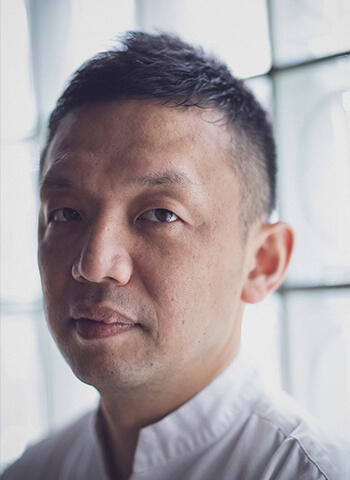


『てのしま』主人 | 日本料理アカデミー正会員
1976年香川県丸亀市生まれ岡山県玉野市育ち。立命館大学卒業後、株式会社菊の井に入社。
2011年上海万博にて『料亭 紫
MURASAKI』(日本産業館内)の料理長として赴任。2011年菊乃井本店副料理長就任、2015年菊乃井赤坂店渉外料理長就任。菊乃井主人村田吉弘氏に師事し、シンガポールエアライン機内食の開発やJR西日本『瑞風』のメニュー開発、国際会議や首相官邸での晩餐会での料理を担当。17カ国以上で和食普及のためのイベントに携わる。また、日本料理を学びたい外国人のための制度作りでは京都府と共に尽力した。
“いりこ”は煮て、干したカタクチイワシをさします。関東ではニボシと呼ばれていますが、ニボシとは本来、“煮て干した出汁素材(水産加工品)”一般を指す言葉で、地方によってはあご(トビウオ)や海老、イワシ、キビナゴ、アジやサバなど様々な素材がニボシとして親しまれています。
僕は瀬戸内で育ち、幼いころから“いりこ”の味に慣れ親しんできました。慣れ親しむということを意識すらしないほど身近な味、母が作る料理のベースは、当たり前のように“いりこ出汁”でした。ただ、日本料理の世界に飛び込んでみると、いりこは決して表の世界に出てくることのない『ケ』(*)の素材でした。調理場ではまかない以外使われることはありません。
仕事で海外に行くことが多くなってきたころ、自分自身の中で何故『出汁』はすべて昆布とかつお節なんだろうという疑問が生まれました。日本料理を象徴するものとして、昆布とかつお節がもてはやされればされるほど、いりこを表舞台に立たせいという想いが僕の中でむくむくと沸き起こってきたのです。
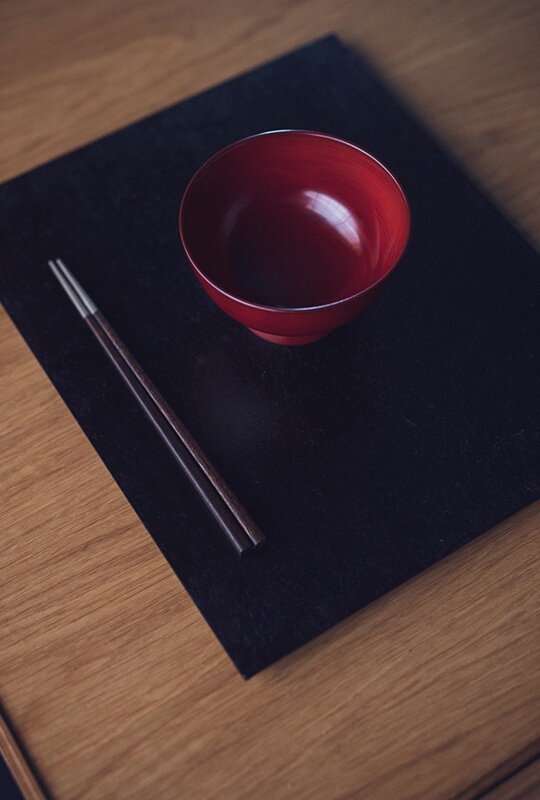
『てのしま』のいりこ煮麺椀
©︎ Osamu KURIHARA / TOKYO-GA


自身の店をもち早く三年、日々料理を作ることに真正面から向き合っています。それは自分自身と向きあうことでもあります。本当に美味しい料理は、しばしば“残心”と言葉で表現されますが、それは翌日ふと思い返したとき、しみじみうまかった、また食べたいなあと思わせる料理のことを指します。その美味しさの表現が当てはまる料理、それは一切気負わず、軽やかで、肩の力が抜けているはずです。
いりこだしこそ、まさに僕が求めていた“肩の力が抜けた”出汁だと気づいて、『てのしま』ではしめに必ずお吸い物代わりにいりこ出汁のにゅうめんをお出ししています。
椀に張ったお出汁を一口飲まれたときのお客様のほっとしたような笑顔を見ると、いつもうれしくなります。
*『ケ』 =日常 「ハレとケ」
ハレ(晴れ・霽れ)は儀式や祭、年中行事などの「非日常」、ケ(褻)は普段の生活である「日常」を表す。
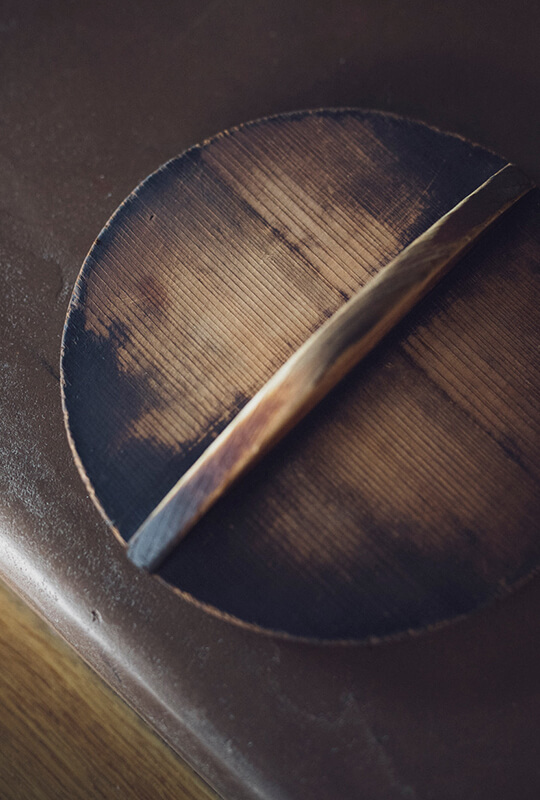
林さん愛用の落し蓋
©︎ Osamu KURIHARA / TOKYO-GA


まず色を見てください。ピカピカの銀色であることが大事。黄色がかったものは脂が酸化しているので美味しくありません。
次に腹部分が割れて無くなっていないものを選びましょう。腹部分がなくなるということは鮮度が悪いものを煮干しにして
いるということを意味します。
家庭でも作り易い分量を目安とします。
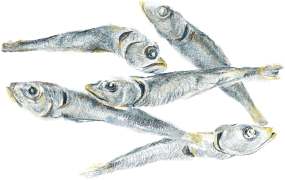
家庭でも作り易い分量を目安とします。
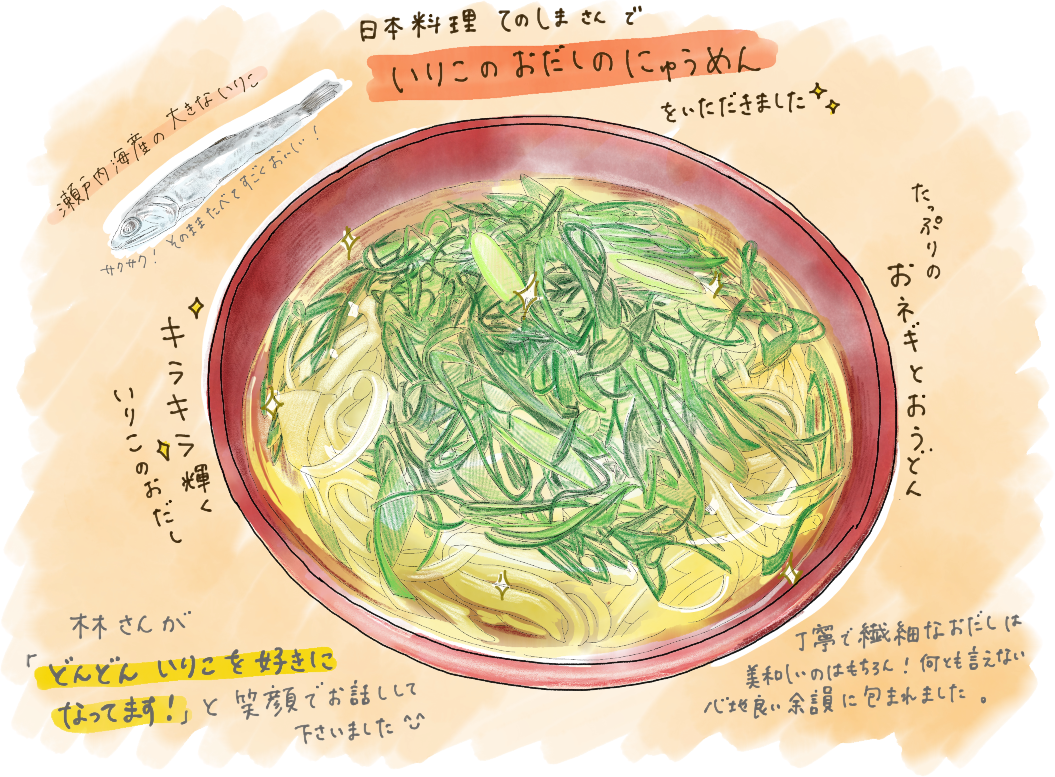
Illustration ©︎ Yuka OHTA
いりこを素材として使うことで出汁をとらなくても、お鍋ひとつで煮物ができます。
新キャベツだけではなく、カブや大根、白菜など季節のお野菜で応用が利くレシピです。
いりこはそのまま頭も腹もついたまま使ってください。



Owner of ‘Tenoshima’ and Full member of the Japanese Culinary Academy
Born in Marugame (Kagawa Prefecture) in 1976, and raised in Tamano City (Okayama Prefecture). After graduating from Ritsumeikan University, he started to work in Kikunoi. After considerable training, in 2011 he was appointed as the head chef of the Japanese restaurant ‘MURASAKI’ in the Japanese Industry Pavilion at the Shanghai World Expo. In the same year, he became sous-chef of Kikunoi’s main restaurant, and in 2015 became the International Liaison head chef of the Kikunoi Akasaka restaurant. Under the guidance of Mr. Yoshihiro Murata, Kikunoi’s owner, he was in charge of developing in-flight meals for Singapore Airlines, developing menus for JR West rail’s "TWILIGHT EXPRESS MIZUKAZE", and preparing food for international conferences and banquets at the Prime Minister's official residence. He has been involved in events to popularise Japanese food in more than 17 countries. In addition, he worked with Kyoto Prefecture to create a system for non-Japanese who want to study Japanese cuisine.
Iriko refers to a boiled and dried small sardine. Although it is called Niboshi in the Kanto region, Niboshi is originally a term used to refer to ‘boiled and dried Dashi stock ingredient (processed seafood product)’, and depending on the region, various ingredients such as flying fish, shrimp, sardine, banded blue-sprat, horse mackerel or mackerel are popular in Niboshi.
I grew up in Setouchi and became accustomed to the taste of Niboshi from a young age. The taste was so familiar I didn’t even realise how familiar it was. The base of the dishes my mother cooked were Niboshi Dashi (soup stock) as a matter of course. However, once I jumped into the world of Japanese cuisine, Iriko was an ingredient seen as Ke (*), and it never appeared on the table. It is used only for meals for the kitchen staff.
As I started to travel overseas more and more for work, I began to question why all the Dashi seemed to be kelp and dried bonito. The more kelp and dried bonito was touted as a symbol of Japanese cuisine, the more the feeling of bringing Iriko to the centre stage began to build inside me.

©︎ Osamu KURIHARA / TOKYO-GA


It has been three years since opening my own restaurant, and I face cooking head-on every day. And it is also about confronting yourself, too. Truly delicious food is often described using the Japanese word Zanshin, and it refers to food that is so delicious that when you think back the next day, you want to eat it again. A dish that deserves this expression of deliciousness should be light and relaxed, and not over-eager.
I realised that Iriko were precisely what I was looking for, it created a ‘relaxed’ Dashi. At Tenoshima, we always serve Iriko Dashi Nyumen (somen noodle soup) instead of Japanese soup. Whenever I see the relaxed face of a customer as they take a sip of the Dashi, it makes me happy.
*Ke = Everyday
Hare & Ke = Hare means something unusual, such a festival, ceremony or annual event, and Ke stands for things in daily life.

©︎ Osamu KURIHARA / TOKYO-GA

